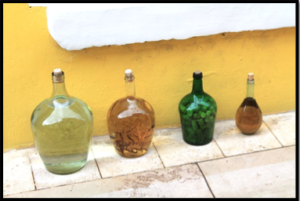Vinegar (a French word for “sour wine”) is one of those things that is largely taken for granted. Once upon a time, vinegar was a ‘must have’ for any kitchen – and not just for cooking with. In fact, vinegar was used for all manner of cleaning, food preservation, and even used for medicinal purposes! It’s a great all around thing to have but to make your own vinegar – now that is one heck of a skill to have. The upside is making vinegar is pretty darn easy!
I’ve done a little in the area of making my own apple cider vinegar (using apple scraps, no less!) last year when I made apple cider vinegar. It turned out really well, I was so proud of my little self! When I tried to make it a second time, it didn’t go so well because I didn’t ensure the apples were fully submerged. This year, when apples go on sale and I start making apple sauce, apple butter, and canning apple pie filling, I plan on making a bunch of the vinegar from the peels and cores. I love it when you can take the ‘waste’ and make something useful out of it!
There are pretty much two types of vinegar starts: Those started with grain and those started with fruit.
I remember having a bad sunburn as a kid. Grandma diluted some white vinegar in water and then smoothed it over my red, angry skin. The cooling feeling of it gave me so much relief, I remember crying because it felt so good. I also remember using it on newspapers to clean glass with, again from grandma. Vinegar is highly acidic and yet still mild, and there are so many non food uses for it! Now that I’m older, I started wondering how white vinegar is made. How all vinegars are made. What I learned is pretty darn cool and so easy, it makes you ask why everyone doesn’t just make their own! Chances are pretty good that you have everything you need in your house already, too.
As we do with all of the “Unraveling the Mystery” articles, we will first dive into the science of vinegar, then cover the equipment needed and the process to make your own vinegar, and lastly, provide you with some links to different kinds of vinegar you can make!
The Science of Vinegar
Vinegar is made via fermentation. Some might call it “ultra” fermenting because vinegar is what happens to alcohol when it’s been left too long. Firs the sugars  make the alcohol, and then the acid makes it into vinegar. Ever have a bottle of sour wine? That’s the start of vinegar. There’s some kind of joke there, I’m sure of it. 😉
make the alcohol, and then the acid makes it into vinegar. Ever have a bottle of sour wine? That’s the start of vinegar. There’s some kind of joke there, I’m sure of it. 😉
To ferment, you need sugar for yeast to eat. That process turns the liquid into alcohol. Once the yeast and sugar have done their dance, the first stage is over. The second stage of making vinegar is letting acetobacter, a harmless bacteria, feed on the alcohol. This process is what makes the vinegar and gives it that sour, distinct taste and scent. Instead of sugary, now it’s acidic. Instead of making a sticky mess, now it cleans sticky messes up. Ah, science!
If you would like to get a more technical explanation on what happens at the microscopic level, you can check out the Wiki page that will tell you all about it (and more!).
There are pretty much two kinds of vinegar types: Those made with fermented grain (rice, corn, etc) and those made with fermented fruit (apples, etc). The fruit or grain is fermented, strained, then sometimes fermented again. You can infuse vinegars with different flavors after fermentation, too.There are numerous ways to make vinegar that are used the world over. Whichever method you choose, there are certain things you need to use (not not use) during the process to end up with your own homemade vinegar.
The Equipment and Process
The equipment needed is pretty minimal, unless you’re doing something overly fancy. It’s easy to buy a bunch of ‘gadgets’ for making vinegar but the truth is, you really don’t need it! Chances are good you already have what you need.
The Equipment
You will need:
- Fruit or grain you plan on fermenting
- Glass, plastic, or pottery bowl(s) and utensils. NO METAL
- A double boiler (or a pot within a pot will work just as well). Typically used for vinegar made with grain.
- Fine Mesh Strainer
- Cheesecloth or other filter to strain out the fine pieces
- Measuring cups, clean cloth, mixing bowl(s)
- VERY CLEAN AREA*
- Jars or bottles to put the vinegar in when it’s ready.
- Time
- Some may want to use fermentation airlocks (though not generally needed in my opinion)
Depending on what you’re making, there may be things here you don’t need and some items not listed that you do need. It would be pretty easy to write a book about making vinegar. The purpose of this post is to show you how easy it is to make your own, not to cover all possibilities.
*You are dealing with fermentation. You want to ensure only the bacteria you want gets into the mix!
The Process
I cannot stress enough how important it is to have a clean working area. Fermentation requires certain bacteria, especially for the second round of fermenting. Also, the use of any metal is a vinegar making no-no. The reason for this is because you are dealing with acidic liquid and when metal comes in contact with it, the chemistry changes. Trust me on this one, it will mess up your batch.
It’s very satisfying to make your own vinegar!
Fruit based vinegar: Mix your sugar and water. Put your fruit (or fruit scraps) into the bowl or jar you’re using. Pour in your sugar mixture (generally 1 TBL to 1 cup of water) until it completely covers the fruit. Make sure to leave some headspace, too! Loosely cover with cheesecloth or maybe a coffee filter. Put it away in a place that will be warm and dark for about 2 weeks. You can stir it every other day if you like. A layer may form on the top, simply skim it off. It’s totally normal.
After 2 weeks, you will be able smell the vinegar but it won’t have the tang you want just yet. It needs another fermentation period but this time, without fruit! Strain the liquid well and then put back into the cupboard, loosely covered, for another 2 weeks (minimum). If it isn’t as tangy or scented the way you prefer, simply let it sit longer!
Rough, right? Grain based vinegar is a little more involved but still easy enough to get it started in an afternoon.
Grain based vinegar: There is more to it when you are using a grain to make your vinegar with. Other than the normal two step fermentation process, you may also need to distill the vinegar which can be rather dangerous. Most people who make their own tend toward using a fruit instead of a grain for this very reason. I don’t know too many people who have a still, let alone know how to safely use it.
White vinegar is generally what you end up with when using grain and an alcohol base. It tends to be very clear and strong, much like what you can buy in the store. The difference is the vinegar in the store is sped up with chemicals and other additives to turn it into something sellable more quickly. The downside is the chemical use, the upside is white vinegar is very inexpensive.
There is so much you can do with this amazing liquid and it’s very satisfying when you make your own vinegar. This article has only made one tiny scratch in the surface of the world of vinegar and I don’t claim to know or have experience with it all – that would be quite the dedication! Even though I may not understand every tiny detail, I feel pretty confident in making and using my own. One less thing to buy at the store!
Additional Resources
- What’s the Difference Between Cider Vinegar and White Vinegar?
- How to Make Chive Blossom Vinegar (Infusion)
- HUGE LIST of Vinegar Recipes!





I’ve never thought of making own vinegar. I’ll have to try it!
It’s pretty darn awesome and you learn a lot about fermenting, too!
I’ve fermented different sauerkrauts, pickles, ketchup but trying this now. My apples floated to the top so weren’t covered by the water/sugar. I put a glass weight on the fruit to keep it submerged. Think this is okay?
That is precisely what you should do!! I had to do the same thing and my first batch was awesome. Second batch, I didn’t notice the fruit wasn’t fully submerged.
Thanks!
So I was wondering, is this vinegar safe for making pickled foods with? I suppose if you used cucumber skins then you could use it for making pickles with, right? Anyway, I’m going to try my hand at making some vinegar from peach scraps. I’ll let you know how it turns out. Oh, and this was my first time to you site btw. I like it!
Thank you! I would not recommend it to be used in pickling because there’s no easy way to tell how much acidity it has. It’s meant more as a cooking in ear versus food preservation. Proceed with caution.
My dad gave me some strawberry wine. It tasted very good, but was way too sweet for me to drink, so we put it into a quart jar, filled almost 3/4 full. I put a couple coffee filters over the top with a rubber band to keep them on tight and put it in a cabinet that isn’t opened everyday. I try not to move the jar often but I do pick it up to look at it once in a while. It smells so wonderful! How long should I leave this set before I have a vinegar I can use for dressings? I really hope this method works.
I would suggest at least a couple weeks but the temperature makes a difference in length of time to turn. Letting wine turn to vinegar is not something I’m very familiar with so I suggest additional research.